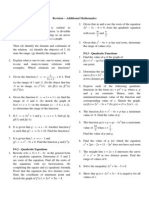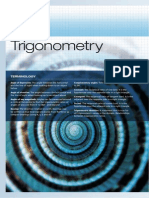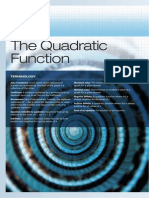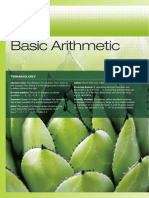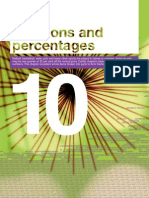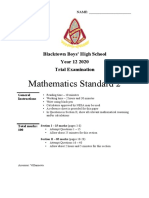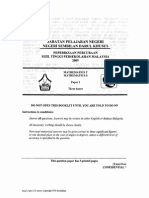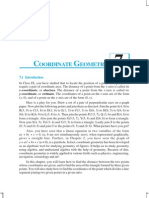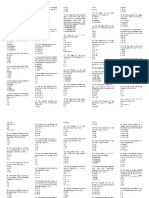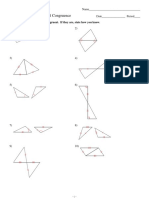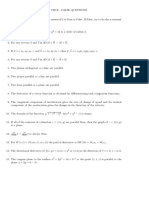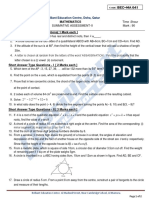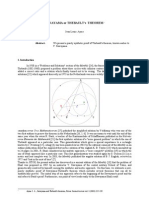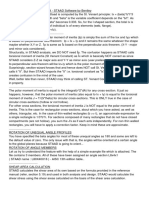Maths in Focus - Margaret Grove - ch7
Maths in Focus - Margaret Grove - ch7
Uploaded by
Sam SchedingCopyright:
Available Formats
Maths in Focus - Margaret Grove - ch7
Maths in Focus - Margaret Grove - ch7
Uploaded by
Sam SchedingOriginal Description:
Copyright
Available Formats
Share this document
Did you find this document useful?
Is this content inappropriate?
Copyright:
Available Formats
Maths in Focus - Margaret Grove - ch7
Maths in Focus - Margaret Grove - ch7
Uploaded by
Sam SchedingCopyright:
Available Formats
7
Linear Functions
TERMINOLOGY
Collinear points: Two or more points that lie on the same straight line Concurrent lines: Two or more lines that intersect at a single point Gradient: The slope of a line measured by comparing the vertical rise over the horizontal run. The symbol for gradient is m Interval: A section of a straight line including the end points Midpoint: A point lying exactly halfway between two points Perpendicular distance: The shortest distance between a point and a line. The distance will be at right angles to the line
Chapter 7 Linear Functions
353
INTRODUCTION
IN CHAPTER 5, YOU STUDIED functions and their graphs. This chapter looks at the linear function, or straight-line graph, in more detail. Here you will study the gradient and equation of a straight line, the intersection of two or more lines, parallel and perpendicular lines, the midpoint, distance and the perpendicular distance from a point to a line.
DID YOU KNOW?
Pierre de Fermat (160165) was a lawyer who dabbled in mathematics. He was a contemporary of Descartes, and showed the relationship between an equation in the form Dx = By, where D and B are constants, and a straight-line graph. Both de Fermat and Descartes only used positive values of x, but de Fermat used the x-axis and y-axis as perpendicular lines as we do today. De Fermats notes Introduction to Loci, Method of Finding Maxima and Minima and Varia opera mathematica were only published after his death. This means that in his lifetime de Fermat was not considered a great mathematician. However, now he is said to have contributed as much as Descartes towards the discovery of coordinate geometry. De Fermat also made a great contribution in his discovery of differential calculus.
Class Assignment
Find as many examples as you can of straight-line graphs in newspapers and magazines.
Distance
The distance between two points (or the length of the interval between two points) is easy to nd when the points form a vertical or horizontal line.
354
Maths In Focus Mathematics Preliminary Course
EXAMPLES
Find the distance between 1. ^ -1, 4 h and ^ -1, -2 h
Solution
Counting along the y-axis, the distance is 6 units. 2. ^ 3, 2 h and ^ -4, 2 h
Solution
Counting along the x-axis, the distance is 7 units.
When the two points are not lined up horizontally or vertically, we use Pythagoras theorem to nd the distance.
Chapter 7 Linear Functions
355
EXAMPLE
Find the distance between points ^ 3, -1 h and ^ -2, 5 h.
Solution
BC = 5 and AC = 6 By Pythagoras theorem, c =a +b AB 2 = 5 2 + 6 2 = 25 + 36 = 61
2 2 2
You studied Pythagoras theorem in Chapter 4.
` AB = 61 Z 7.81
DID YOU KNOW?
Pythagoras made many discoveries about music as well as about mathematics. He found that changing the length of a vibrating string causes the tone of the music to change. For example, when a string is halved, the tone is one octave higher.
The distance between two points _ x 1, y 1 i and _ x 2, y 2 i is given by d=
2 2 _ x2 - x1 i + _ y2 - y1 i
356
Maths In Focus Mathematics Preliminary Course
Proof
If points A and B were changed around, the formula would be d = (x 1 - x 2 ) + (y 1 - y 2 ) ,
2 2
Let A = _ x 1, y 1 i and B = _ x 2, y 2 i Length AC = x 2 - x 1 and length BC = y 2 - y 1 By Pythagoras theorem AB 2 = AC 2 + BC 2 d 2 = _ x 2 - x 1 i2 + _ y 2 - y 1 i2 `d=
2 2 _ x2 - x1 i + _ y2 - y1 i
which would give the same answer.
EXAMPLES
1. Find the distance between the points ^ 1, 3 h and ^ -3, 0 h.
Solution
Let ^ 1, 3 h be _ x 1, y 1 i and ^ -3, 0 h be _ x 2, y 2 i d=
2 2 _ x2 - x1 i + _ y2 - y1 i
= ] -3 - 1 g2 + ] 0 - 3 g2 = ] -4 g2 + ] -3 g2 = 16 + 9 = 25 =5 So the distance is 5 units. 2. Find the exact length of AB given that A = ^ -2, -4 h and B = ^ -1, 5 h .
Solution
Let ^ -2, -4 h be _ x 1, y 1 i and ^ -1, 5 h be _ x 2, y 2 i d= =
You would still get 82 if you used (- 2, - 4) as (x 2 , y 2 ) and (-1, 5) as (x 1 , y 1 ).
2 2 _ x2 - x1 i + _ y2 - y1 i
6 -1 - ^ -2 h @ 2 + 6 5 - ^ -4 h @ 2
12 + 92 1 + 81 82
= = =
Chapter 7 Linear Functions
357
7.1 Exercises
1. Find the distance between points (a) ^ 0, 2 h and ^ 3, 6 h (b) ^ -2, 3 h and ^ 4, -5 h (c) ^ 2, -5 h and ^ -3, 7 h Find the exact length of the interval between points (a) ^ 2, 3 h and ^ -1, 1 h (b) ^ -5, 1 h and ^ 3, 0 h (c) ^ - 2, -3 h and ^ - 4, 6 h (d) ^ -1, 3 h and ^ -7, 7 h Find the distance, correct to 2 decimal places, between points (a) ^ 1, -4 h and ^ 5, 5 h (b) ^ 0, 4 h and ^ 3, -2 h (c) ^ 8, -1 h and ^ -7, 6 h Find the perimeter of D ABC with vertices A ^ 3, 1 h, B ^ -1, 1 h and C ^ -1, -2 h . Prove that the triangle with vertices ^ 3, 4 h, ^ -2, 7 h and ^ 6, -1 h is isosceles. Show that AB = BC, where A = ^ -2, 5 h, B = ^ 4, -2 h and C = ^ -3, -8 h . Show that points ^ 3, -4 h and ^ 8,1 h are equidistant from point ^ 7, -3 h . A circle with centre at the origin O passes through the point _ 2 , 7 i . Find the radius of the circle, and hence its equation. Prove that the points X _ 2 , -3 i, Y _ -1, 10 i and Z _ - 6 , 5 i all lie on a circle with centre at the origin. Find its equation. 12. Prove that A ^ 1, 4 h, B ^ 1, 2 h and C _ 1 + 3 , 3 i are the vertices of an equilateral triangle. 13. If the distance between ^ a, 3 h and ^ 4, 2 h is 37 , nd the values of a. 14. The points M ^ -1, -2 h, N (3, 0), P ^ 4, 6 h and Q ^ 0, 4 h form a quadrilateral. Prove that MQ = NP and QP = MN. What type of quadrilateral is MNPQ? 15. Show that the diagonals of a square with vertices A ^ -2, 4 h, B ^ 5, 4 h, C ^ 5, -3 h and D ^ -2, -3 h are equal. 16. (a) Show that the triangle with vertices A ^ 0, 6 h, B ^ 2, 0 h and C ^ -2, 0 h is isosceles. (b) Show that perpendicular OA, where O is the origin, bisects BC. 17. Find the exact length of the diameter of a circle with centre ^ -3, 4 h if the circle passes through the point ^ 7, 5 h . 18. Find the exact length of the radius of the circle with centre (1, 3) if the circle passes through the point ^ -5, -2 h . 19. Show that the triangle with vertices A ^ -2, 1 h, B ^ 3, 3 h and C ^ 7, -7 h is right angled. 20. Show that the points X ^ 3, -3 h, Y ^ 7, 4 h and Z ^ - 4, 1 h form the vertices of an isosceles right-angled triangle.
2.
3.
4.
5.
6.
7.
8.
9.
10. If the distance between ^ a, -1 h and ^ 3, 4 h is 5, nd the value of a. 11. If the distance between ^ 3, -2 h and ^ 4, a h is 7 , nd the exact value of a.
358
Maths In Focus Mathematics Preliminary Course
Midpoint
The midpoint is the point halfway between two other points.
The midpoint of two points _ x 1, y 1 i and _ x 2, y 2 i is given by M=e x1 + x2 y1 + y2 o , 2 2
Proof
Can you see why these triangles are similar?
Find the midpoint of points A _ x 1, y 1 i and B _ x 2, y 2 i. Let M = ^ x, y h Then D APQ < ; D ABR AQ AP = AR AB x - x1 1 ` x -x = 2 2 1 2 _ x - x1 i = x2 - x1 2x - 2x 1 = x 2 - x 1 2x = x 1 + x 2 x1 + x2 ` x= 2 y1 + y2 Similarly, y = 2 `
EXAMPLES
1. Find the midpoint of ^ -1, 4 h and ^ 5, 2 h.
Solution
x= x1 + x2 2
Chapter 7 Linear Functions
359
-1 + 5 2 4 = 2 =2 y1 + y2 y= 2 4+2 = 2 6 = 2 =3 So M = (2, 3) . = 2. Find the values of a and b if ^ 2, -3 h is the midpoint between ^ -7, -8 h and ^ a, b h.
Solution
2 -7 + a 2= 2 4 = -7 + a 11 = a y1 + y2 y= 2 -8 + b -3 = 2 -6 = -8 + b 2=b So a = 11 and b = 2. x= x1 + x2
Note that the x-coordinate of the midpoint is the average of x 1 and x 2 . The same applies to the y-coordinate.
PROBLEM
A timekeeper worked out the average time for 8 nalists in a race. The average was 30.55, but the timekeeper lost one of the nalists times. The other 7 times were 30.3, 31.1, 30.9, 30.7, 29.9, 31.0 and 30.3. Can you nd out the missing time?
360
Maths In Focus Mathematics Preliminary Course
7.2 Exercises
1. Find the midpoint of (a) ^ 0, 2 h and ^ 4, 6 h (b) ^ -2, 3 h and ^ 4, -5 h (c) ^ 2, -5 h and ^ -6, 7 h (d) ^ 2, 3 h and ^ -8, 1 h (e) ^ -5, 2 h and ^ 3, 0 h (f) ^ -2, -2 h and ^ -4, 6 h (g) ^ 1, -4 h and ^ 5, 5 h (h) ^ 0, 4 h and ^ 3, -2 h (i) ^ 8, -1 h and ^ -7, 6 h (j) ^ 3, 7 h and ^ -3, 4 h Find the values of a and b if (a) ^ 4, 1 h is the midpoint of ^ a, b h and ^ -1, 5 h (b) ^ -1, 0 h is the midpoint of ^ a, b h and ^ 3, -6 h (c) ^ a, 2 h is the midpoint of (3, b h and ^ -5, 6 h (d) ^ -2, 1 h is the midpoint of ^ a, 4 h and ^ -3, b h (e) ^ 3, b h is the midpoint of ^ a, 2 h and ^ 0, 0 h Prove that the origin is the midpoint of ^ 3, -4 h and ^ -3, 4 h . Show that P = Q where P is the midpoint of ^ -2, 3 h and ^ 6, -5 h and Q is the midpoint of ^ -7, -5 h and ^ 11, 3 h . Find the point that divides the interval between ^ 3, -2 h and ^ 5, 8 h in the ratio of 1:1. Show that the line x = 3 is the perpendicular bisector of the interval between the points ^ -1, 2 h and ^ 7, 2 h . 7. The points A ^ -1, 2 h, B ^ 1, 5 h, C ^ 6, 5 h and D ^ 4, 2 h form a parallelogram. Find the midpoints of the diagonals AC and BD. What property of a parallelogram does this show? The points A ^ 3, 5 h, B ^ 9, -3 h, C ^ 5, -6 h and D ^ -1, 2 h form a quadrilateral. Prove that the diagonals are equal and bisect one another. What type of quadrilateral is ABCD? A circle with centre ^ -2, 5 h has one end of a diameter at ^ 4, -3 h . Find the coordinates of the other end of the diameter.
8.
2.
9.
3.
4.
10. A triangle has vertices at A ^ -1, 3 h, B ^ 0, 4 h and C ^ 2, -2 h . (a) Find the midpoints X, Y and Z of sides AB, AC and BC respectively. 1 (b) Show that XY = BC, 2 1 1 XZ = AC and YZ = AB. 2 2 11. Point P ^ x, y h moves so that the midpoint between P and the origin is always a point on the circle x 2 + y 2 = 1. Find the equation of the locus of P. 12. Find the equation of the locus of the point P ^ x, y h that is the midpoint between all points on the circle x 2 + y 2 = 4 and the origin.
5.
The locus is the path that P (x, y) follows.
6.
Gradient
The gradient of a straight line measures its slope. The gradient compares the vertical rise with the horizontal run.
Chapter 7 Linear Functions
361
rise Gradient = run
On the number plane, this is a measure of the rate of change of y with respect to x.
The rate of change of y with respect to x is a very important measure of their relationship. In later chapters you will use the gradient for many purposes, including sketching curves, nding the velocity and acceleration of objects, and nding maximum and minimum values of formulae.
EXAMPLES
Find the gradient of each interval. 1.
You will study the gradient at different points on a curve in the next chapter.
Solution
rise Gradient = run 2 = 3
CONTINUED
362
Maths In Focus Mathematics Preliminary Course
2.
Solution
In this case, x is - 3 (the run is measured towards the left). rise Gradient = run 2 = -3 2 =3
Positive gradient leans to the right.
Negative gradient leans to the left.
Gradient given 2 points
The gradient of the line between _ x 1, y 1 i and _ x 2, y 2 i is given by y2 - y1 m= x -x 2 1
Proof
Chapter 7 Linear Functions
363
BC = y 2 - y 1 and AC = x 2 - x 1 rise Gradient = run y2 - y1 = x -x 2 1
This formula could also be y1 - y2 written m = x1 - x2
EXAMPLES
1. Find the gradient of the line between points ^ 2, 3 h and ^ -3, 4 h .
Solution
y2 - y1 Gradient: m = x - x 2 1 4-3 = -3 - 2 1 = -5 1 =5 2. Prove that points ^ 2, 3 h, ^ -2, -5 h and ^ 0, -1 h are collinear.
Collinear points lie on the same line, so they have the same gradients.
Solution
To prove points are collinear, we show that they have the same gradient (slope).
CONTINUED
364
Maths In Focus Mathematics Preliminary Course
Gradient of the interval between ^ -2, -5 h and ^ 0, -1 h : y2 - y1 m= x -x 2 1 -1 - ] -5 g = 0 - ] -2 g -1 + 5 = 2 4 = 2 =2 Gradient of the interval between ^ 0, -1 h and ^ 2, 3 h : y2 - y1 m= x -x 2 1 3 - ] -1 g = 2-0 3+1 = 2 4 = 2 =2 Since the gradient of both intervals is the same, the points are collinear.
Gradient given the angle at the x-axis
The gradient of a straight line is given by m = tan i where i is the angle the line makes with the x-axis in the positive direction
Proof
rise m = run opposite = adjacent = tan i
Chapter 7 Linear Functions
365
For an acute angle tan i 2 0.
For an obtuse angle tan i 1 0.
Class Discussion
1. Which angles give a positive gradient? 2. Which angles give a negative gradient? Why? 3. What is the gradient of a horizontal line? What angle does it make with the x-axis? 4. What angle does a vertical line make with the x-axis? Can you nd its gradient?
EXAMPLES
1. Find the gradient of the line that makes an angle of 135c with the x-axis in the positive direction.
Solution
m = tan i = tan 135c = -1
Can you see why the gradient is negative?
2. Find the angle, in degrees and minutes, that a straight line makes with the x-axis in the positive direction if its gradient is 0.5.
Solution
m = tan i ` tan i = 0.5 i = 26c34l
366
Maths In Focus Mathematics Preliminary Course
7.3 Exercises
1. Find the gradient of the line between (a) ^ 3, 2 h and ^ 1, -2 h (b) ^ 0, 2 h and ^ 3, 6 h (c) ^ -2, 3 h and ^ 4, -5 h (d) ^ 2, -5 h and ^ -3, 7 h (e) ^ 2, 3 h and ^ -1, 1 h (f) ^ - 5, 1 h and ^ 3, 0 h (g) ^ -2, -3 h and ^ -4, 6 h (h) ^ -1, 3 h and ^ -7, 7 h (i) ^ 1, -4 h and ^ 5, 5 h (j) ^ 0, 4 h and ^ 3, -2 h If the gradient of _ 8, y 1 i and ^ -1, 3 h is 2, nd the value of y 1 . The gradient of ^ 2, -1 h and ^ x, 0 h is 5. Find the value of x. 9. A triangle has vertices A ^ 3, 1 h, B ^ -1, -4 h and C ^ -11, 4 h . (a) By nding the lengths of all sides, prove that it is a rightangled triangle. (b) Find the gradients of sides AB and BC.
2.
10. (a) Find the midpoints F and G of sides AB and AC where ABC is a triangle with vertices A ^ 0, 3 h, B ^ 2, -7 h and C ^ 8, -2 h . (b) Find the gradients of FG and BC. 11. The gradient of the line between a moving point P ^ x, y h and the point A ^ 5, 3 h is equal to the gradient of line PB where B has coordinates ^ 2, -1 h . Find the equation of the locus of P. 12. Prove that the points ^ 3, -1 h, ^ 5, 5 h and ^ 2, -4 h are collinear. 13. Find the gradient of the straight line that makes an angle of 45c with the x-axis in the positive direction. 14. Find the gradient, to 2 signicant gures, of the straight line that l with makes an angle of 42c51 the x-axis. 15. Find the gradient of the line that makes an angle of 87c14l with the x-axis, to 2 signicant gures. 16. Find the angle, in degrees and minutes, that a line with gradient 1.2 makes with the x-axis. 17. What angle, in degrees and minutes does the line with gradient 3 make with the x-axis in the positive direction?
3.
4.
The gradient of a line is 1 and the line passes through the points ^ 4, 2 h and ^ x, -3 h . Find the value of x. 5. (a) Show that the gradient of the line through ^ -2, 1 h and ^ 3, 4 h is equal to the gradient of the line between the points ^ 2, -1 h and ^ 7,2 h . (b) Draw the two lines on the number plane. What can you say about the lines? 6. Show that the points A ^ -1, 2 h, B ^ 1, 5 h, C ^ 6, 5 h and D ^ 4, 2 h form a parallelogram. Find the gradients of all sides. The points A ^ 3, 5 h, B ^ 9, -3 h, C ^ 5, -6 h and D ^ -1, 2 h form a rectangle. Find the gradients of all the sides and the diagonals. Find the gradients of the diagonals of the square with vertices A ^ -2, 1 h, B ^ 3, 1 h, C ^ 3, 6 h and D ^ -2, 6 h .
7.
8.
Chapter 7 Linear Functions
367
18. Find the exact gradient of the line that makes an angle with the x-axis in the positive direction of (a) 60c (b) 30c (c) 120c. 19. Show that the line passing through ^ 4, -2 h and ^ 7, -5 h
makes an angle of 135c with the x-axis in the positive direction. 20. Find the exact value of x with rational denominator if the line passing through ^ x, 3 h and ^ 2, 1 h makes an angle of 60c with the x-axis.
Gradient given an equation
In Chapter 5 you explored and graphed linear functions. You may have noticed a relationship between the graph and the gradient and y-intercept of a straight line.
Investigation
1. (i) Draw the graph of each linear function. (ii) By selecting two points on the line, nd its gradient. (a) y = x (b) y = 2x (c) y = 3x (d) y = - x (e) y = - 2x Can you nd a pattern for the gradient of each line? Can you predict what the gradient of y = 5x and y = - 9x would be? 2. (i) Draw the graph of each linear function. (ii) Find the y-intercept. (a) y = x (b) y = x + 1 (c) y = x + 2 (d) y = x - 2 (e) y = x - 3 Can you nd a pattern for the y-intercept of each line? Can you predict what the y-intercept of y = x + 11 and y = x - 6 would be?
y = mx + b has m = gradient b = y-intercept
368
Maths In Focus Mathematics Preliminary Course
EXAMPLES
1. Find the gradient and y-intercept of the linear function y = 7x - 5.
Solution
The equation is in the form y = mx + b where m = 7 and b = - 5. Gradient = 7 y-intercept = - 5 2. Find the gradient of the straight line with equation 2x + 3y - 6 = 0.
Solution
First, we change the equation into the form y = mx + b. 2x + 3y - 6 = 0 2x + 3y - 6 + 6 = 0 + 6 2x + 3y = 6 2x - 2x + 3y = 6 - 2x 3y = 6 - 2x = - 2x + 6 3y - 2x + 6 = 3 3 - 2x 6 y= + 3 3 2 = - x +2 3 2 m=3 2 So the gradient is - . 3
There is a general formula for nding the gradient of a straight line.
The gradient of the line ax + by + c = 0 is given by m=a b
Proof
ax + by + c = 0 by = - ax - c ax c y=b b a ` m=b
Chapter 7 Linear Functions
369
EXAMPLE
Find the gradient of 3x - y = 2.
Solution
3x - y = 2 3x - y - 2 = 0 a = 3, b = - 1 a m=b 3 =-1 =3 ` gradient is 3
7.4 Exercises
1. Find (i) the gradient and (ii) the y-intercept of each linear function. (a) y = 3x + 5 (b) f ] x g = 2x + 1 (c) y = 6x - 7 (d) y = - x (e) y = - 4x + 3 (f) y = x - 2 (g) f ] x g = 6 - 2x (h) y = 1 - x (i) y = 9x (j) y = 5x - 2 Find (i) the gradient and (ii) the y-intercept of each linear function. (a) 2x + y - 3 = 0 (b) 5x + y + 6 = 0 (c) 6x - y - 1 = 0 (d) x - y + 4 = 0 (e) 4x + 2y - 1 = 0 (f) 6x - 2y + 3 = 0 (g) x + 3y + 6 = 0 (h) 4x + 5y - 10 = 0 (i) 7x - 2y - 1 = 0 (j) 5x - 3y + 2 = 0 3. Find the gradient of the straight line. (a) y = 4x (b) y = - 2x - 1 (c) y = 2 (d) 2x + y - 5 = 0 (e) x + y + 1 = 0 (f) 3x + y = 8 (g) 2x - y + 5 = 0 (h) x + 4y - 12 = 0 (i) 3x - 2y + 4 = 0 (j) 5x - 4y = 15 2 (k) y = x + 3 3 x (l) y = 2 x (m) y = - 1 5 2x (n) y = +5 7 3x -2 (o) y = 5 x 1 (p) 2y = - + 7 3 y (q) 3x - = 8 5 x y (r) + =1 2 3 2x (s) - 4y - 3 = 0 3 x 2y + +7=0 (t) 4 3
2.
370
Maths In Focus Mathematics Preliminary Course
Equation of a Straight Line
There are several different ways to write the equation of a straight line.
General form
ax + by + c = 0
Gradient form
y = mx + b where m = gradient and b = y-intercept
Intercept form
x y a+b =1 where a and b are the x-intercept and y-intercept respectively
Proof
b m = - a, b = b ` b y = -ax + b y ` b y x = -a + 1
x a+b =1
Point-gradient formula
There are two formulae for nding the equation of a straight line. One of these uses a point and the gradient of the line.
The equation of a straight line is given by y - y1 = m _ x - x1 i
This is a very useful formula as it is used in many topics in this course.
where _ x 1, y 1 i lies on the line with gradient m
Chapter 7 Linear Functions
371
Proof
Given point _ x 1, y 1 i on the line with gradient m Let P = ^ x, y h Then line AP has gradient y2 - y1 m= x -x 2 1 y - y1 ` m= x-x 1 m _ x - x1 i = y - y1
Two-point formula
The equation of a straight line is given by y - y1 y2 - y1 = x - x1 x2 - x1 where _ x 1, y 1 i and _ x 2, y 2 i are points on the line
This formula is optional as you can use the pointgradient formula for any question.
Proof
The gradient is the same anywhere along a straight line.
Let P = ^ x, y h D APQ < ; D ABR PQ BR So = AR AQ y - y1 y2 - y1 i.e. x - x = x - x 1 2 1 The two-point formula is not essential. The right-hand side of it is the gradient of the line. Replacing this by m gives the pointgradient formula.
372
Maths In Focus Mathematics Preliminary Course
EXAMPLES
1. Find the equation of the straight line with gradient -4 and passing through the point ^ -2, 3 h .
Solution
m = -4, x 1 = -2 and y 1 = 3 Equation: y - y 1 = m (x - x 1) y - 3 = - 4 [x - (-2)] = - 4 (x + 2) = - 4x - 8 ` y = - 4x - 5 or 4x + y + 5 = 0
(gradient form) (general form)
2. Find the equation of the straight line that passes through the points ^ 2, -3 h and ^ -4, -7 h .
Solution
By two-point formula: y - y1 y2 - y1 = x - x1 x2 - x1 y - ] -7 g -3 - ] -7 g = x - ] -4 g 2 - ] -4 g y+7 -3 + 7 = x+4 2+4 y+7 2 = x+4 3 3 ^ y + 7 h = 2 ]x + 4 g 3y + 21 = 2x + 8 -2x + 3y + 13 = 0 or 2x - 3y - 13 = 0 By point-gradient method: y2 - y1 m= x -x 2 1 -3 - ] -7 g = 2 - ] -4 g -3 + 7 = 2+4 2 = 3 Use one of the points, say ^ -4, -7 h . 2 m = , x 1 = -4 and y 1 = -7 3 Equation: y - y 1 = m ( x - x 1) y - (-7) = 2 6 x - ( - 4) @ 3
Chapter 7 Linear Functions
373
y+7= 3^ y + 7h 3y + 21 ` -2x + 3y + 13 or 2x - 3y - 13
2 ( x + 4) 3 = 2 ]x + 4 g = 2x + 8 =0 =0
3. Find the equation of the line with x-intercept 3 and y-intercept 2.
Solution
x y Intercept form is a + = 1, where a and b are the x-intercept and b y-intercept respectively. x y ` + =1 3 2 2x + 3y = 6 ` 2x + 3y - 6 = 0 Again, the point-gradient formula can be used. The x-intercept and y-intercept are the points ^ 3, 0 h and ^ 0, 2 h .
7.5 Exercises
1. Find the equation of the straight line (a) with gradient 4 and y-intercept -1 (b) with gradient -3 and passing through ^ 0, 4 h (c) passing through the origin with gradient 5 (d) with gradient 4 and x-intercept -5 (e) with x-intercept 1 and y-intercept 3 (f) with x-intercept 3, y-intercept -4 (g) with y-intercept -1 and making an angle of 45c with the x-axis in the positive direction (h) with y-intercept 5 and making an angle of 45c with the x-axis in the positive direction. 2. Find the equation of the straight line that makes an angle of 135c with the x-axis and passes through the point ^ 2, 6 h . Find the equation of the straight line passing through (a) ^ 2, 5 h and ^ -1, 1 h (b) ^ 0, 1 h and ^ -4, -2 h (c) ^ - 2, 1 h and ^ 3, 5 h (d) ^ 3, 4 h and ^ -1, 7 h (e) ^ -4, -1 h and ^ - 2, 0 h . What is the equation of the line with x-intercept 2 and passing through ^ 3, -4 h ? Find the equation of the line (a) parallel to the x-axis and passing through ^ 2, 3 h (b) parallel to the y-axis and passing through ^ -1, 2 h .
3.
4.
5.
374
Maths In Focus Mathematics Preliminary Course
6.
A straight line passing through the origin has a gradient of - 2. Find its equation. A straight line has x-intercept 4 and passes through ^ 0, -3 h . Find its equation. Find the equation of the straight line with gradient -2 that passes through the midpoint of ^ 5, -2 h and ^ -3, 4 h .
9.
7.
What is the equation of the straight line through the point ^ -4, 5 h and the midpoint of ^ 1, 2 h and ^ -9, 4 h ?
8.
10. What is the equation of the straight line through the midpoint of ^ 0, 1 h and ^ -6, 5 h and the midpoint of ^ 2, 3 h and ^ 8, -3 h ?
Parallel and Perpendicular Lines
Parallel lines
Class Investigation
Sketch the following straight lines on the same number plane. 1. y = 2x 2. y = 2x + 1 3. y = 2x - 3 4. y = 2x + 5 What do you notice about these lines?
If two lines are parallel, then they have the same gradient. That is, m1 = m2
Two lines that are parallel have equations ax + by + c 1 = 0 and ax + by + c 2 = 0
Chapter 7 Linear Functions
375
Proof
a b a ax + by + c 2 = 0 has gradient m 2 = b Since m 1 = m 2, the two lines are parallel. ax + by + c 1 = 0 has gradient m 1 = -
EXAMPLES
1. Prove that the straight lines 5x - 2y - 1 = 0 and 5x - 2y + 7 = 0 are parallel.
Solution
5x - 2y - 1 = 0 5x - 1 = 2y 5 1 x- =y 2 2 5 ` m1 = 2 5x - 2y + 7 = 0 5x + 7 = 2y 5 7 x+ =y 2 2 5 ` m2 = 2 5 m1 = m2 = 2 ` the lines are parallel. 2. Find the equation of a straight line parallel to the line 2x - y - 3 = 0 and passing through ^ 1, -5 h .
Notice that the equations are both in the form 5x - 2y + k = 0.
Solution
2x - y - 3 = 0 2x - 3 = y ` m1 = 2 For parallel lines m 1 = m 2 ` m2 = 2 Equation: y - y 1 = m (x - x 1) y - (-5) = 2 (x - 1) y + 5 = 2x - 2 0 = 2x - y - 7
376
Maths In Focus Mathematics Preliminary Course
DID YOU KNOW?
Parallel lines are usually thought of as lines that never meet. However, there is a whole branch of geometry based on the theory that parallel lines meet at infinity. This is called affine geometry. In this geometry there are no perpendicular lines.
Perpendicular lines
Class Investigation
Sketch the following pairs of straight lines on the same number plane. 1. (a) 3x - 4y + 12 = 0 2. (a) 2x + y + 4 = 0 (b) 4x + 3y - 8 = 0 (b) x - 2y + 2 = 0
What do you notice about these pairs of lines?
Gradients of perpendicular lines are negative reciprocals of each other.
If two lines with gradients m 1 and m 2 respectively are perpendicular, then m 1 m 2 = -1 1 i.e. m 2 = - m 1
Proof
Let line AB have gradient m 1 = tan a . Let line CD have gradient m 2 = tan b. EB EC +CBE = 180c - a EC tan ] 180c - a g = EB EB ` cot ] 180c - a g = EC tan b =
^ straight angle h
Chapter 7 Linear Functions
377
So or
tan b = cot ] 180c - a g = - cot a 1 =tan a 1 m2 = - m 1 m 1 m 2 = -1
Perpendicular lines have equations in the form ax + by + c 1 = 0 and bx - ay + c 2 = 0
Proof
a b b bx - ay + c 2 = 0 has gradient m 2 = - - a b =a a b m1 m2 = - # a b = -1 ax + by + c 1 = 0 has gradient m 1 = Since m 1 m 2 = -1, the two lines are perpendicular.
EXAMPLES
1. Show that the lines 3x + y - 11 = 0 and x - 3y + 1 = 0 are perpendicular.
Solution
3x + y - 11 = 0 y = -3x + 11 m 1 = -3 ` x - 3y + 1 = 0 x + 1 = 3y 1 1 x+ =y 3 3 1 ` m2 = 3 1 m 1 m 2 = - 3# 3 = -1 ` the lines are perpendicular.
Notice that the equations are in the form 3x + y + c 1 = 0 and x - 3y + c 2 = 0.
CONTINUED
378
Maths In Focus Mathematics Preliminary Course
2. Find the equation of the straight line through ^ 2, 3 h perpendicular to the line that passes through ^ -1, 7 h and ^ 3, 3 h .
Solution
Line through ^ -1, 7 h and ^ 3, 3 h: y2 - y1 m= x -x 2 1 7-3 m1 = -1 - 3 4 = -4 = -1 For perpendicular lines, m 1 m 2 = - 1 i.e. -1m 2 = - 1 m2 = 1 Equation through ^ 2, 3 h: y - y 1 = m (x - x 1) y - 3 = 1 (x - 2 ) =x-2 0=x-y+1
7.6 Exercises
1. Find the gradient of the straight line (a) parallel to the line 3x + y - 4 = 0 (b) perpendicular to the line 3x + y - 4 = 0 (c) parallel to the line joining ^ 3, 5 h and ^ -1, 2 h (d) perpendicular to the line with x-intercept 3 and y-intercept 2 (e) perpendicular to the line making an angle of 135c with the x-axis in the positive direction (f) perpendicular to the line 6x - 5y - 4 = 0 (g) parallel to the line making an angle of 30c with the x-axis (h) parallel to the line x - 3y - 7 = 0 (i) perpendicular to the line making an angle of 120c with the x-axis in the positive direction (j) perpendicular to the line passing through ^ 4, -2 h and ^ 3, 3 h . 2. Find the equation of each straight line (a) passing through ^ 2, 3 h and parallel to the line y = x + 6 (b) through ^ -1, 5 h and parallel to the line x - 3y - 7 = 0 (c) with x-intercept 5 and parallel to the line y = 4 - x (d) through ^ 3, -4 h and perpendicular to the line y = 2x (e) through ^ -2, 1 h and perpendicular to the line 2x + y + 3 = 0
Chapter 7 Linear Functions
379
(f) through ^ 7, -2 h and perpendicular to the line 3x - y - 5 = 0 (g) through ^ -3, -1 h and perpendicular to the line 4x - 3y + 2 = 0 . 3. Show that the straight lines y = 3x - 2 and 6x - 2y - 9 = 0 are parallel. Show that lines x + 5y = 0 and y = 5x + 3 are perpendicular. Show that lines 6x - 5y + 1 = 0 and 6x - 5y - 3 = 0 are parallel. Show that lines 7x + 3y + 2 = 0 and 3x - 7y = 0 are perpendicular. If the lines 3x - 2y + 5 = 0 and y = kx - 1 are perpendicular, nd the value of k. Show that the line joining ^ 3, -1 h and ^ 2, -5 h is parallel to the line 8x - 2y - 3 = 0. Show that the points A ^ -3, -2 h, B ^ -1, 4 h, C ^ 7, -1 h, and D ^ 5, -7 h are the vertices of a parallelogram.
4.
11. Find the equation of the straight line (a) passing through the origin and parallel to the line x+y+3=0 (b) through ^ 3, 7 h and parallel to the line 5x - y - 2 = 0 (c) through ^ 0, - 2 h and perpendicular to the line x - 2y = 9 (d) perpendicular to the line 3x + 2y - 1 = 0 and passing through the point ^ -2, 4 h . 12. Find the equation of the straight line passing through ^ 6, -3 h that is perpendicular to the line joining ^ 2, -1 h and ^ -5, -7 h . 13. Find the equation of the line through ^ 2, 1 h that is parallel to the line that makes an angle of 135c with the x-axis in the positive direction. 14. Find the equation of the perpendicular bisector of the line passing through ^ 6, -3 h and ^ -2, 1 h . 15. Find the equation of the straight line parallel to the line 2x - 3y - 1 = 0 and through the midpoint of ^ 1, 3 h and ^ -1, 9 h .
5.
6.
7.
8.
9.
10. The points A ^ -2, 0 h, B ^ 1, 4 h, C ^ 6, 4 h and D ^ 3, 0 h form a rhombus. Show that the diagonals are perpendicular.
Intersection of Lines
Two straight lines intersect at a single point ^ x, y h . The point satises the equations of both lines. We nd this point by solving simultaneous equations.
You may need to revise simultaneous equations from Chapter 3.
380
Maths In Focus Mathematics Preliminary Course
Concurrent lines meet at a single point. To show that lines are concurrent, solve two simultaneous equations to nd the point of intersection. Then substitute this point of intersection into the third and subsequent lines to show that these lines also pass through the point.
EXAMPLES
1. Find the point of intersection between lines 2x - 3y - 3 = 0 and 5x - 2y - 13 = 0.
Solution
Solve simultaneous equations: 2x - 3y - 3 = 0 5x - 2y - 13 = 0 4x - 6y - 6 = 0 ^ 1 h # 2: 15x - 6y - 39 = 0 ^ 2 h # 3: + 33 = 0 ^ 3 h - ^ 4 h: -11x 33 = 11x 3=x Substitute x = 3 into ^ 1 h:
You could use a computer spreadsheet to solve these simultaneous equations.
^1h ^2h ^3h ^4h
2 ^ 3 h - 3y - 3 = 0 - 3y + 3 = 0 3 = 3y 1=y So the point of intersection is ^ 3, 1 h . 2. Show that the lines 3x - y + 1 = 0, x + 2y + 12 = 0 and 4x - 3y - 7 = 0 are concurrent.
Solution
Solve any two simultaneous equations: 3x - y + 1 = 0 x + 2y + 12 = 0 4x - 3y - 7 = 0 6x - 2y + 2 = 0 ^ 1 h # 2: 2 + 4 : 7 x + 14 = 0 ^ h ^ h
^1h ^2h ^3h ^4h
Chapter 7 Linear Functions
381
7x = -14 x = -2 Substitute x = -2 into ^ 1 h: 3 ^ -2 h - y + 1 = 0 -y - 5 = 0 -5 = y So the point of intersection of (1) and (2) is ^ -2, -5 h . Substitute ^ -2, -5 h into (3): 4x - 3y - 7 = 0 LHS = 4 ^ -2 h - 3 ^ - 5 h - 7 = -8 + 15 - 7 =0 = RHS So the point lies on line (3) ` all three lines are concurrent.
Equation of a line through the intersection of 2 other lines
To nd the equation of a line through the intersection of 2 other lines, nd the point of intersection, then use it with the other information to nd the equation. Another method uses a formula to nd the equation.
If a 1 x + b 1 y + c 1 = 0 and a 2 x + b 2 y + c 2 = 0 are 2 given lines then the equation of a line through their intersection is given by the formula (a 1 x + b 1 y + c 1) + k (a 2 x + b 2 y + c 2) = 0 where k is a constant
Proof
Let l 1 have equation a 1 x + b 1 y + c 1 = 0. Let l 2 have equation a 2 x + b 2 y + c 2 = 0. Let the point of intersection of l 1 and l 2 be P ^ x 1, y 1 h . Then P satises l 1 i.e. a 1 x 1 + b 1 y 1 + c 1 = 0 P also satises l2 i.e. a 2 x 1 + b 2 y 1 + c 2 = 0 Substitute P into (a 1 x + b 1 y + c 1) + k (a 2 x + b 2 y + c 2) = 0 (a 1 x 1 + b 1 y 1 + c 1) + k (a 2 x 1 + b 2 y 1 + c 2) = 0 0 + k ^0h = 0 0=0 ` if point P satises both equations l 1 and l 2 then it satises l 1 + kl 2 = 0.
382
Maths In Focus Mathematics Preliminary Course
EXAMPLE
Find the equation of the line through ^ -1, 2 h that passes through the intersection of lines 2x + y - 5 = 0 and x - 3y + 1 = 0.
Solution
Using the formula: a 1 = 2, b 1 = 1, c 1 = -5 a 2 = 1, b 2 = -3, c 2 = 1
Substitute the value of k back into the equation.
^ a1 x + b1 y + c1 h + k ^ a2 x + b2 y + c2 h = 0 ^ 2x + y - 5 h + k ^ x - 3y + 1 h = 0 Since this line passes through ^ -1, 2 h, substitute the point into the equation: ^ -2 + 2 - 5 h + k ^ -1 - 6 + 1 h = 0 -5 - 6k = 0 -5 = 6k 5 - =k 6 So the equation becomes: 5 ^ 2x + y - 5 h - ^ x - 3y + 1 h = 0 6 6 ^ 2x + y - 5 h - 5 ^ x - 3 y + 1 h = 0 12x + 6y - 30 - 5x + 15y - 5 = 0 7x + 21y - 35 = 0 x + 3y - 5 = 0 Another way to do this example is to nd the point of intersection, then use both points to nd the equation.
7.7 Exercises
1. Find the point of intersection of straight lines (a) 3x + 4y + 10 = 0 and 2x - 3y - 16 = 0 (b) 5x + 2y + 11 = 0 and 3x + y + 6 = 0 (c) 7x - 3y = 16 and 5x - 2y = 12 (d) 2x - 3y = 6 and 4x - 5y = 10 (e) x - 3y - 8 = 0 and 4x + 7y - 13 = 0 (f) y = 5x + 6 and y = - 4x - 3 (g) y = 2x + 1 and 5x - 3y + 6 = 0 (h) 3x + 7y = 12 and 4x - y - 1 6 = 0 (i) 3x - 5y = - 7 and 2x - 3y = 4 (j) 8x - 7y - 3 = 0 and 5x - 2y - 1 = 0 2. Show that the lines x - 2y - 11 = 0 and 2x - y - 10 = 0 intersect at the point ^ 3, -4 h . A triangle is formed by 3 straight lines with equations 2 x - y + 1 = 0, 2 x + y - 9 = 0
3.
Chapter 7 Linear Functions
383
and 2x - 5y - 3 = 0. Find the coordinates of its vertices. 4. Show that the lines x - 5y - 17 = 0, 3x - 2y - 12 = 0 and 5x + y - 7 = 0 are concurrent. Show that the lines x + 4y + 5 = 0, 3x - 7y + 15 = 0, 2x - y + 10 = 0 and 6x + 5y + 30 = 0 are concurrent. Find the equation of the straight line through the origin that passes through the intersection of the lines 5x - 2y + 14 = 0 and 3x + 4y - 7 = 0 . Find the equation of the straight line through ^ 3, 2 h that passes through the intersection of the lines 5x + 2y + 1 = 0 and 3x - y + 16 = 0. Find the equation of the straight line through ^ -4, -1 h that passes through the intersection of the lines 2x + y - 1 = 0 and 3x + 5y + 16 = 0. Find the equation of the straight line through ^ -3, 4 h that passes through the intersection of the lines 2x + y - 3 = 0 and 3x - 2y - 8 = 0 .
12. Find the equation of the straight line through ^ -1, -2 h that passes through the intersection of the lines 2x + y - 6 = 0 and 3 x + 7 y - 9 = 0. 13. Find the equation of the straight line through ^ 1, 2 h that passes through the intersection of the lines x + 2y + 10 = 0 and 2x - y + 5 = 0. 14. Find the equation of the straight line through ^ -2, 0 h that passes through the intersection of the lines 3x + 4y - 7 = 0 and 3 x - 2 y - 1 = 0. 15. Find the equation of the straight line through ^ 3, -2 h that passes through the intersection of the lines 5x + 2y - 13 = 0 and x - 3y + 11 = 0. 16. Find the equation of the straight line through ^ -3, -2 h that passes through the intersection of the lines x + y + 1 = 0 and 3x + 2y = 0 . 17. Find the equation of the straight line through ^ 3, 1 h that passes through the intersection of the lines 3x - y + 4 = 0 and 2x - y + 12 = 0. 18. Find the equation of the straight line with gradient 3 that passes through the intersection of the lines 2x + y - 1 = 0 and 3x + 5y + 16 = 0. 19. Find the equation of the straight line with gradient 2 that passes through the intersection of the lines 5x - 2y - 3 = 0 and 7x - 3y - 4 = 0 .
5.
6.
7.
8.
9.
10. Find the equation of the straight line through ^ 2, -2 h that passes through the intersection of the lines 2x + 3y - 6 = 0 and 3x + 5y - 10 = 0. 11. Find the equation of the straight line through ^ 3, 0 h that passes through the intersection of the lines x - y + 1 = 0 and 4x - y - 2 = 0 .
384
Maths In Focus Mathematics Preliminary Course
20. Find the equation of the straight line parallel to the line 3x - y - 7 = 0 that passes through the intersection of the lines 3x - 2y - 10 = 0 and 4x + y - 17 = 0.
21. Find the equation of the straight line perpendicular to the line x + 5y - 1 = 0 that passes through the intersection of lines 3x - 5y - 3 = 0 and 2x + 3y + 17 = 0.
Perpendicular Distance
The distance formula d = _ x 2 - x 1 i2 + _ y 2 - y 1 i2 is used to nd the distance between two points. Perpendicular distance is used to nd the distance between a point and a line. If we look at the distance between a point and a line, there could be many distances.
So we choose the shortest distance, which is the perpendicular distance.
The perpendicular distance from _ x 1, y 1 i to the line ax + by + c = 0 is
A distance is always positive, so take the absolute value.
given by d =
| ax 1 + by 1 + c | a2 + b2
Proof
Chapter 7 Linear Functions
385
Let d be the perpendicular distance of _ x 1, y 1 i from the line ax + by + c = 0. - ax 1 - c c c o C = c 0, - m R = e x 1, A = b- a , 0 l b b In D ACO, AC = = = PR = y 1 - e = c2 c2 + a2 b2 c2 b2 + c2 a2 a2 b2 c a2 + b2 ab
o
To find A and C, substitute y = 0 and x = 0 into ax + by + c = 0.
- ax 1 - c
b ax 1 + by 1 + c b
D ACO is similar to D PRQ ` PQ PR = AO AC AO . PR PQ = AC ax 1 + by 1 + c c a2 + b2 c d=a# ' b ab c _ ax 1 + by 1 + c i ab = # ab c a2 + b2 ax 1 + by 1 + c = a2 + b2
Why?
All points on one side of the line ax + by + c = 0 make the numerator of this formula positive. Points on the other side make the numerator negative. Usually we take the absolute value of d. However, if we want to know if points are on the same side of a line or not, we look at the sign of d.
EXAMPLES
1. Find the perpendicular distance of ^ 4, - 3 h from the line 3x - 4y - 1 = 0.
Solution
x 1 = 4, y 1 = - 3, a = 3, b = - 4, c = - 1 | ax 1 + by 1 + c | d= a2 + b2 | 3 ] 4 g + ] - 4 g ] -3 g + ] -1 g | = 3 2 + ] -4 g2
CONTINUED
386
Maths In Focus Mathematics Preliminary Course
25 23 = 5 = 4 .6 So the perpendicular distance is 4.6 units. 2. Prove that the line 6x + 8y + 20 = 0 is a tangent to the circle x 2 + y 2 = 4.
| 12 + 12 - 1 |
Solution
There are three possibilities for the intersection of a circle and a straight line.
The centre of the circle x 2 + y 2 = 4 is ^ 0, 0 h and its radius is 2 units. A tangent is perpendicular to the centre of the circle. So we prove that the perpendicular distance from the line to the point ^ 0, 0 h is 2 units (the radius). | ax 1 + by 1 + c | d= a2 + b2 | 6 (0) + 8 (0) + 20 | = 62 + 82 | 20 | = 100 20 = 10 =2 ` the line is a tangent to the circle. 3. Show that the points ^ -1, 3 h and ^ 2, 7 h lie on the same side of the line 2 x - 3 y + 4 = 0.
Chapter 7 Linear Functions
387
Solution
To show that points lie on the same side of a line, their perpendicular distance must have the same sign. We use the formula without the absolute value sign. d= ax 1 + by 1 + c a2 + b2
^ - 1, 3 h : 2 ]-1 g - 3 ]3 g + 4 d= 22 + ] - 3 g 2 -2 - 9 + 4 = 4+9 -7 = 13 ^ 2, 7 h : 2 ]2 g - 3 ]7 g + 4 d= 2 2 + ] -3 g 2 4 - 21 + 4 = 4+9 - 13 = 13
Since the perpendicular distance for both points has the same sign, the points lie on the same side of the line.
7.8 Exercises
1. Find the perpendicular distance between (a) ^ 1, 2 h and 3x + 4y + 2 = 0 (b) ^ - 3, 2 h and 5x + 12y + 7 = 0 (c) ^ 0, 4 h and 8x - 6y - 1 = 0 (d) ^ - 3, - 2 h and 4x - 3y - 6 = 0 (e) the origin and 12x - 5y + 8 = 0. Find, correct to 3 signicant gures, the perpendicular distance between (a) ^ 1, 3 h and x + 3y + 1 = 0 (b) ^ -1, 1 h and 2x + 5y + 4 = 0 (c) ^ 3, 0 h and 5x - 6y - 12 = 0 (d) ^ 5, - 3 h and 4x - y - 2 = 0 (e) ^ - 6, - 3 h and 2x - 3y + 9 = 0. 3. Find as a surd with rational denominator the perpendicular distance between (a) the origin and the line 3x - 2y + 7 = 0 (b) ^ -1, 4 h and 2x + y + 3 = 0 (c) ^ 3, -1 h and 3x + 14y + 1 = 0 (d) ^ 2, - 6 h and 5x - y - 6 = 0 (e) ^ - 4, - 1 h and 3 x - 2 y - 4 = 0. Show that the origin is equidistant from the lines 7x + 24y + 25 = 0, 4x + 3y - 5 = 0 and 12x + 5y - 13 = 0.
2.
4.
388
Maths In Focus Mathematics Preliminary Course
5.
Show that points A ^ 3, - 5 h and B ^ -1, 4 h lie on opposite sides of 2x - y + 3 = 0. Show that the points ^ 2, - 3 h and ^ 9, 2 h lie on the same side of the line x - 3y + 2 = 0. Show that ^ - 3, 2 h and ^ 4, 1 h lie on opposite sides of the line 4 x - 3 y - 2 = 0. Show that ^ 0, - 2 h is equidistant from the lines 3x + 4y - 2 = 0 and 12x - 5y + 16 = 0. Show that the points ^ 8, - 3 h and ^ 1, 1 h lie on the same side of the line 6x - y + 4 = 0.
6.
14. Find the perpendicular distance between ^ 0, 5 h and the line through ^ - 3, 8 h parallel to 4x - 3y - 1 = 0. 15. The perpendicular distance between the point ^ x, -1 h and the line 3x - 4y + 7 = 0 is 8 units. Find two possible values of x. 16. The perpendicular distance between the point ^ 3, b h and the line 5x - 12y - 2 = 0 is 2 units. Find the values of b. 17. Find m if the perpendicular distance between ^ m, 7 h and the line 9x + 12y + 6 = 0 is 5 units. 18. Prove that the line 3x - 4y + 25 = 0 is a tangent to the circle with centre the origin and radius 5 units. 19. Show that the line 3x - 4y + 12 = 0 does not cut the circle x 2 + y 2 = 1. 20. The sides of a triangle are formed by the lines with equations 2x - y - 7 = 0, 3x + 5y - 4 = 0 and x + 3y - 4 = 0. (a) Find the vertices of the triangle. (b) Find the exact length of all the altitudes of the triangle.
7.
Equidistant means that two or more objects are the same distance away from another object.
8.
9.
10. Show that ^ - 3, 2 h and ^ 4, 1 h lie on opposite sides of the line 2x + y - 2 = 0. 11. Show that the point ^ 3, - 2 h is the same distance from the line 6x - 8y + 6 = 0 as the point ^ - 4, -1 h is from the line 5x + 12y - 20 = 0. 12. Find the exact perpendicular distance with rational denominator from the point ^ 4, 5 h to the line with x-intercept 2 and y-intercept -1. 13. Find the perpendicular distance from ^ - 2, 2 h to the line passing through ^ 3, 7 h and ^ -1, 4 h .
Chapter 7 Linear Functions
389
Test Yourself 7
1. Find the distance between points ^ - 1, 2 h and ^ 3, 7 h . What is the midpoint of the origin and the point ^ 5, - 4 h ? Find the gradient of the straight line (a) passing through ^ 3, -1 h and ^ - 2, 5 h (b) with equation 2x - y + 1 = 0 (c) making an angle of 30c with the x-axis in the positive direction (d) perpendicular to the line 5 x + 3 y - 8 = 0. Find the equation of the linear function (a) passing through ^ 2, 3 h and with gradient 7 (b) parallel to the line 5x + y - 3 = 0 and passing through ^ 1, 1 h (c) through the origin, and perpendicular to the line 2x - 3y + 6 = 0 (d) through ^ 3, 1 h and ^ - 2, 4 h (e) with x-intercept 3 and y-intercept 1. Find the perpendicular distance between ^ 2, 5 h and the line 2x - y + 7 = 0 in surd form with rational denominator. Prove that the line between ^ -1, 4 h and ^ 3, 3 h is perpendicular to the line 4x - y - 6 = 0. Find the x- and y-intercepts of 2x - 5y - 10 = 0. (a) Find the equation of the straight line l that is perpendicular to the line 1 y = x - 3 and passes through ^ 1, -1 h . 2 (b) Find the x-intercept of l. (c) Find the exact distance from ^ 1, -1 h to the x-intercept of l. Prove that lines y = 5x - 7 and 10x - 2y + 1 = 0 are parallel. 10. Find the equation of the straight line passing through the origin and parallel to the line with equation 3x - 4y + 5 = 0. 11. Find the point of intersection between lines y = 2x + 3 and x - 5y + 6 = 0. 12. The midpoint of ^ a, 3 h and ^ - 4, b h is ^ 1, 2 h . Find the values of a and b. 13. Show that the lines x - y - 4 = 0, 2x + y + 1 = 0, 5x - 3y - 14 = 0 and 3x - 2y - 9 = 0 are concurrent. 14. A straight line makes an angle of 153c 29l with the x-axis in the positive direction. What is its gradient, to 3 signicant gures? 15. The perpendicular distance from ^ 3, - 2 h to the line 5x - 12y + c = 0 is 2. Find 2 possible values of c. 16. Find the equation of the straight line through ^ 1, 3 h that passes through the intersection of the lines 2x - y + 5 = 0 and x + 2y - 5 = 0. 17. The gradient of the line through ^ 3, - 4 h and ^ x, 2 h is 5. Evaluate x. 18. Show that the points ^ - 2, 1 h and ^ 6, 3 h are on opposite sides of the line 2 x - 3 y - 1 = 0. 19. Find the equation of the line with x-intercept 4 that makes an angle of 45c with the x-axis. 20. Find the equation of the line with y-intercept - 2 and perpendicular to the line passing through ^ 3, -2 h and ^ 0, 5 h .
2.
3.
4.
5.
6.
7.
8.
9.
390
Maths In Focus Mathematics Preliminary Course
Challenge Exercise 7
1. If points ^ - 3k, 1 h, ^ k - 1, k - 3 h and ^ k - 4, k - 5 h are collinear, nd the value of k. Find the equation, in exact form, of the line passing through _ 3 , -2 i that makes an angle of 30c with the positive x-axis. Find the equation of the circle whose centre is at the origin and with tangent x - 3y + 9 = 0. ABCD is a rhombus where A = ^ - 3, 0 h, B = ^ 0, 4 h, C = ^ 5, 4 h and D = ^ 2, 0 h . Prove that the diagonals are perpendicular bisectors of one another. Prove that the points _ -1, 2 2 i, _ 3 , - 6 i and _ - 5 , 2 i all lie on a circle with centre the origin. What are the radius and equation of the circle? Find the exact distance between the parallel lines 3x + 2y - 5 = 0 and 3x + 2y = 1. A straight line has x-intercept A ^ a, 0 h and y-intercept B ^ 0, b h, where a and b are positive integers. The gradient of line AB is -1. Find +OBA where O is the origin and hence prove that a = b. Find the exact perpendicular distance between the line 2x + 3y + 1 = 0 and the point of intersection of lines 3x - 7y = 15 and 4x - y = - 5. Find the magnitude of the angle, in degrees and minutes, that the line joining ^ -1, 3 h and ^ 2, - 4 h makes with the x-axis in the positive direction. 10. Find the equation of the line that passes through the point of intersection of lines 2x + 5y + 19 = 0 and 4x - 3y - 1 = 0 that is perpendicular to the line 3x - 2y + 1 = 0. 11. Prove A ^ 2, 5 h, B ^ - 4, 5 h and C ^ -1, 2 h are the vertices of a right-angled isosceles triangle. 12. Find the coordinates of the centre of a circle that passes through points ^ 7, 2 h, ^ 2, 3 h and ^ -4, -1 h . 13. If ax - y - 2 = 0 and bx - 5y + 11 = 0 intersect at the point ^ 3, 4 h, nd the values of a and b. 14. Find the equation of the straight line through ^ 3, -4 h that is perpendicular to the line with x-intercept and y-intercept 2 and 5 respectively. 15. Find the exact equation of the straight line through the midpoint of ^ 0, - 5 h, and ^ 4, -1 h that is perpendicular to the line that makes an angle of 30c with the x-axis. 16. Point P ^ x, y h moves so that it is equidistant from points A ^ 1, 4 h and B ^ - 2, 7 h . By nding the distances AP and BP, nd the equation of the locus of P.
2.
3.
4.
5.
6.
7.
8.
9.
You might also like
- Form 4 Additional Mathematics Revision QuestionsDocument4 pagesForm 4 Additional Mathematics Revision QuestionsManisha Sekaran Muniandy60% (5)
- Maths in Focus, Margaret Grove - PrelimsDocument13 pagesMaths in Focus, Margaret Grove - PrelimsSam Scheding45% (11)
- Maths in Focus - Margaret Grove - AnsDocument65 pagesMaths in Focus - Margaret Grove - AnsSam Scheding100% (2)
- Maths in Focus - Margaret Grove - ch5Document74 pagesMaths in Focus - Margaret Grove - ch5Sam SchedingNo ratings yet
- Further Pure 2 and 3 For OcrDocument14 pagesFurther Pure 2 and 3 For Ocrmardel110% (2)
- CH 1 Collecting and Presenting DataDocument56 pagesCH 1 Collecting and Presenting DataHarry White100% (2)
- New Century Maths 10 Essentials - Chapter 09 - ProbabilityDocument16 pagesNew Century Maths 10 Essentials - Chapter 09 - ProbabilityMariuum ShortiiNo ratings yet
- New A-Level Maths Exam Practice Workbook (Dragged) 2 PDFDocument4 pagesNew A-Level Maths Exam Practice Workbook (Dragged) 2 PDFTrúc Hồ100% (1)
- Maths in Focus - Margaret Grove - ch5Document74 pagesMaths in Focus - Margaret Grove - ch5Sam SchedingNo ratings yet
- 5e Lesson Plan Coordinate SystemDocument8 pages5e Lesson Plan Coordinate Systemapi-234725699No ratings yet
- Linear Function - Maths in FocusDocument47 pagesLinear Function - Maths in FocusRicha Ng100% (1)
- Maths in Focus - Margaret Grove - ch10Document52 pagesMaths in Focus - Margaret Grove - ch10Sam Scheding100% (2)
- Maths in Focus - Margaret Grove - ch6Document78 pagesMaths in Focus - Margaret Grove - ch6Sam Scheding50% (4)
- Maths in Focus - Margaret Grove - ch3Document42 pagesMaths in Focus - Margaret Grove - ch3Sam Scheding100% (2)
- Maths in Focus - Margaret Grove - ch9Document34 pagesMaths in Focus - Margaret Grove - ch9Sam Scheding0% (1)
- Maths in Focus - Margaret Grove - ch8Document54 pagesMaths in Focus - Margaret Grove - ch8Sam Scheding100% (1)
- Maths in Focus - Margaret Grove - ch4Document59 pagesMaths in Focus - Margaret Grove - ch4Sam Scheding100% (3)
- Yr12 Maths in Focus 2U HSCDocument412 pagesYr12 Maths in Focus 2U HSCRichard Yang93% (14)
- Maths in Focus - Margaret Grove - ch2Document50 pagesMaths in Focus - Margaret Grove - ch2Sam Scheding100% (1)
- Chapter Four of Maths in FocusDocument33 pagesChapter Four of Maths in FocusRishi MáranNo ratings yet
- HSC Maths Ext1 CH2Document54 pagesHSC Maths Ext1 CH2moustafasadek11No ratings yet
- Prelim MathsInFocus EXT1Document861 pagesPrelim MathsInFocus EXT1Elijah Prado100% (7)
- Chapter 3Document28 pagesChapter 3chiarat101No ratings yet
- Maths Methods Notes Unit 4 2011 End-Year-2Document109 pagesMaths Methods Notes Unit 4 2011 End-Year-2Lei LiNo ratings yet
- Number: 10 NCM7 2nd Ed SB TXT - FM Page 336 Saturday, June 7, 2008 6:00 PMDocument42 pagesNumber: 10 NCM7 2nd Ed SB TXT - FM Page 336 Saturday, June 7, 2008 6:00 PMBella FuroloNo ratings yet
- Further Maths Textbook 2016Document880 pagesFurther Maths Textbook 2016peter smith75% (4)
- Maths in Focus Chapter 11Document52 pagesMaths in Focus Chapter 11eccentricftw450% (2)
- Ch1 Geometry 2Document47 pagesCh1 Geometry 2trantuanan123No ratings yet
- MathematicsDocument41 pagesMathematicsRudra Saha0% (1)
- Chapter 2Document28 pagesChapter 2Bella FuroloNo ratings yet
- A Level Futher Mathematics PDFDocument21 pagesA Level Futher Mathematics PDFNkengafac Armstrong menjuaNo ratings yet
- Practice Test - Algebra 1Document6 pagesPractice Test - Algebra 1Felix LeNo ratings yet
- 2020 MS - Blacktown Boys HS - Trial Paper (With Solutions) PDFDocument60 pages2020 MS - Blacktown Boys HS - Trial Paper (With Solutions) PDFCameron Hutcherson100% (1)
- Jacaranda VCE Maths Quest 11Document36 pagesJacaranda VCE Maths Quest 11ApnaNo ratings yet
- Maths Refresher Workbook 1Document42 pagesMaths Refresher Workbook 1KBNo ratings yet
- Bound NotesDocument121 pagesBound Noteseermac949No ratings yet
- 7 Maths WorksheetsDocument41 pages7 Maths WorksheetsTarak BhardwajNo ratings yet
- AQA Core 3 Revision BookletDocument20 pagesAQA Core 3 Revision Bookletjake1731No ratings yet
- Probability For GCSEDocument33 pagesProbability For GCSESteve Bishop100% (1)
- 1Document11 pages1Nhu NguyenNo ratings yet
- Igcse BookletDocument19 pagesIgcse BookletArman JavedNo ratings yet
- Gcse Maths A Linear 2540Document108 pagesGcse Maths A Linear 2540siddharthmenonNo ratings yet
- ch12 PDFDocument53 pagesch12 PDFcathy100% (1)
- Chapter 2Document44 pagesChapter 2chiarat101100% (1)
- STP Mathematics 8 Chapter10 FormulasDocument17 pagesSTP Mathematics 8 Chapter10 Formulaspasha khan100% (1)
- HSC 4 Unit Extension 2 Mathematics Dot Point OutlineDocument117 pagesHSC 4 Unit Extension 2 Mathematics Dot Point OutlineRey Rey100% (4)
- E-Book 'Pure Maths Part Two - Integration' From A-Level Maths TutorDocument39 pagesE-Book 'Pure Maths Part Two - Integration' From A-Level Maths TutorA-level Maths Tutor100% (2)
- Ed Excel A Level Course GuideDocument8 pagesEd Excel A Level Course GuideAkhilGovind100% (1)
- GCSE Mathematics Numerical Crosswords Higher Tier Written for the GCSE 9-1 CourseFrom EverandGCSE Mathematics Numerical Crosswords Higher Tier Written for the GCSE 9-1 CourseNo ratings yet
- Elementary School ‘Grades 3, 4 & 5: Math – Shape, Space and Measures - Ages 8-11’ eBookFrom EverandElementary School ‘Grades 3, 4 & 5: Math – Shape, Space and Measures - Ages 8-11’ eBookNo ratings yet
- The Ultimate ECAA Guide: Economics Admissions Assessment. Latest specification with 300+ practice questions with fully worked solutions, time saving techniques, score boosting strategies, and formula sheets.From EverandThe Ultimate ECAA Guide: Economics Admissions Assessment. Latest specification with 300+ practice questions with fully worked solutions, time saving techniques, score boosting strategies, and formula sheets.No ratings yet
- STPM Trials 2009 Math T Paper 1 (Negeri Sembilan)Document3 pagesSTPM Trials 2009 Math T Paper 1 (Negeri Sembilan)Jessica JonesNo ratings yet
- S4 Amath 1Document6 pagesS4 Amath 1Teo Liang WeiNo ratings yet
- 46 THE POINT DDDDDDDDDDDDDDDDocument22 pages46 THE POINT DDDDDDDDDDDDDDDVishal VjNo ratings yet
- FIRST TERM (LEVEL - 2) PAPER - 1Document6 pagesFIRST TERM (LEVEL - 2) PAPER - 1kandolkarsamarth44No ratings yet
- AnGeom Bridging 1Document10 pagesAnGeom Bridging 1blackmasqueNo ratings yet
- STPM 2005Document2 pagesSTPM 2005Shu NeeNo ratings yet
- Problems: Ted Eisenberg, Section EditorDocument16 pagesProblems: Ted Eisenberg, Section Editorสฮาบูดีน สาและNo ratings yet
- STPM Mathematics T Past Year Question P1 P2 P3Document19 pagesSTPM Mathematics T Past Year Question P1 P2 P3Sou Voyage0% (3)
- 9709 s05 QP 1 PDFDocument4 pages9709 s05 QP 1 PDFtess_15No ratings yet
- Jemh 107Document18 pagesJemh 107myNo ratings yet
- 5th Coordinate Geometry Worksheet 3Document1 page5th Coordinate Geometry Worksheet 3Paul Jerick LaraNo ratings yet
- 2013 Metrobank-MTAP - Dep-Ed Math Challenge 4th YearDocument7 pages2013 Metrobank-MTAP - Dep-Ed Math Challenge 4th YearChrisseMarthaGillesania100% (1)
- Maths in Focus - Margaret Grove - Pat 1Document5 pagesMaths in Focus - Margaret Grove - Pat 1Sam SchedingNo ratings yet
- Maths in Focus - Margaret Grove - ch8Document54 pagesMaths in Focus - Margaret Grove - ch8Sam Scheding100% (1)
- Maths in Focus - Margaret Grove - ch4Document59 pagesMaths in Focus - Margaret Grove - ch4Sam Scheding100% (3)
- Maths in Focus - Margaret Grove - ch2Document50 pagesMaths in Focus - Margaret Grove - ch2Sam Scheding100% (1)
- CH 1Document42 pagesCH 1jess_sweetNo ratings yet
- Inverse Jeemain - GuruDocument32 pagesInverse Jeemain - GuruNeetu GuptaNo ratings yet
- Ghyhy PDFDocument21 pagesGhyhy PDFSimran MadanNo ratings yet
- Fcalc03 PPT 07Document90 pagesFcalc03 PPT 07Zeinab ElkholyNo ratings yet
- 2ndyear20yrs Chapter WiseDocument41 pages2ndyear20yrs Chapter WiseqalatiNo ratings yet
- Maxima and Minima ProblemsDocument44 pagesMaxima and Minima ProblemsMeggy Villanueva100% (2)
- In Defense of Advertising in SpaceDocument11 pagesIn Defense of Advertising in Spacejhhuebert5297100% (3)
- University Questions and Answers On TensorsDocument16 pagesUniversity Questions and Answers On TensorsSunipa PurkaitNo ratings yet
- Isomerism: One or More Than One Answer Type Questions: 1. Which One of The Following Pairs of Isomers Are EnentiomersDocument11 pagesIsomerism: One or More Than One Answer Type Questions: 1. Which One of The Following Pairs of Isomers Are EnentiomerskamalNo ratings yet
- How Can You Best Explain Divergence and CurlDocument8 pagesHow Can You Best Explain Divergence and CurlattiquejavaidNo ratings yet
- Lect BalancingDocument72 pagesLect BalancingTalha KhanzadaNo ratings yet
- Bead On WireDocument11 pagesBead On WireAshish BansalNo ratings yet
- ROSE, Gillian. Progress in Geography and Gender. or Sometinh ElseDocument7 pagesROSE, Gillian. Progress in Geography and Gender. or Sometinh Elsethais_ng-1No ratings yet
- As Level Co-Ordinates, Points & LinesDocument14 pagesAs Level Co-Ordinates, Points & Lines-----No ratings yet
- Pertemuan 2Document17 pagesPertemuan 2Syarifah Humaira Al'mudhirNo ratings yet
- Review Module 08 Integral Calculus Part 2Document1 pageReview Module 08 Integral Calculus Part 2Andrea MagtutoNo ratings yet
- Problemas Resueltos Estatica EquilibrioDocument2 pagesProblemas Resueltos Estatica EquilibriopabloNo ratings yet
- Planar Kinetics of A Rigid Body: Force & AccelerationDocument41 pagesPlanar Kinetics of A Rigid Body: Force & AccelerationZoker_45No ratings yet
- Basic Engineering Correlation (Analytic Geometry) PDFDocument3 pagesBasic Engineering Correlation (Analytic Geometry) PDFsephNo ratings yet
- Triangle Congruence WorksheetDocument4 pagesTriangle Congruence WorksheetCameron SharpeNo ratings yet
- Geo y Trigo - Week 3Document14 pagesGeo y Trigo - Week 3Mateo Sierra0% (1)
- Vector True False PracticeDocument4 pagesVector True False PracticeSivakumar RamakrishnanNo ratings yet
- Mr. Abdurahiman Kundil 18782SA2-Set-MA041 (2017-03)Document2 pagesMr. Abdurahiman Kundil 18782SA2-Set-MA041 (2017-03)newtonfogg123No ratings yet
- Sawayama or Thebault's TheoremDocument4 pagesSawayama or Thebault's TheoremMike Nannos100% (1)
- 10th Maths Value Based QuestionsDocument11 pages10th Maths Value Based QuestionsAyush TripathiNo ratings yet
- Torsion Moment Inertia STAADDocument2 pagesTorsion Moment Inertia STAADAngelo MoralNo ratings yet
- Domain & Range: Differential Calculus Home Work Sheet #1Document11 pagesDomain & Range: Differential Calculus Home Work Sheet #1Crystal ClearNo ratings yet
- Spanish TVDocument28 pagesSpanish TVhassanbasha72No ratings yet
- 2D Geometric Shapes FlashcardsDocument7 pages2D Geometric Shapes FlashcardsMajho CanilangNo ratings yet
- COSMOS: Complete Online Solutions Manual Organization SystemDocument7 pagesCOSMOS: Complete Online Solutions Manual Organization Systemcurrjek0% (2)
